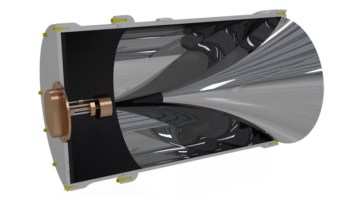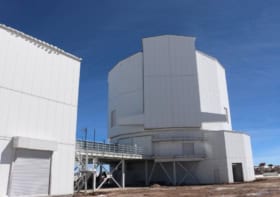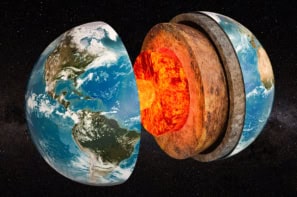
Stellar explosions known as type Ia supernovae could be triggered by dark matter. So says a physicist in the US, who has worked out how certain burnt-out stars can explode even though they lack the mass to generate fusion reactions. According to the new research, the stars ignite because they accumulate so-called asymmetric dark matter, which, if real, could be detectable in a new generation of earthbound experiments.
Asymmetric dark matter, like familiar visible matter, would come in both matter and antimatter varieties. It was proposed on the basis that the density of dark matter in the universe today, as revealed by its gravitational interactions, is only about five times that of normal matter. In cosmological terms, the two matter densities are almost identical, and this suggests a common link between visible and dark matter. That being a very slight imbalance between matter and antimatter, which, following mutual annihilation in the early universe, resulted in the densities observed today.
This similarity does not apply to the current favourite dark-matter particles – weakly interacting massive particles (WIMPs) – which are their own antiparticles and could not have undergone a lopsided annihilation.
Explosive burst
In the latest work, Joseph Bramante of the University of Notre Dame in Indiana looked for evidence of asymmetric dark matter in observations of type Ia supernovae, the “standard candles” that showed the universe’s expansion to be accelerating. Such supernovae are thought to be generated by white dwarfs, the very dense burnt-out remnants of Sun-like stars. Normally, white dwarfs are not massive enough to compress to the point where their internal temperature allows fusion reactions to take place. But astrophysicists believe they can accumulate additional mass by sucking material from nearby stars. They would eventually reach the “Chandrasekhar limit” of about 1.4 solar masses, at which point they would collapse and then blow apart as a result of an explosive burst of fusion energy.
However, as Bramante points out, a 2014 study of the light emitted by a sample of relatively nearby type Ia supernovae showed that many of the associated white dwarfs failed to reach the Chandrasekhar limit, with some weighing as little as 0.9 solar masses. Other researchers have proposed that white dwarfs might merge with one another to ignite supernovae, but Bramante says that the low density of white-dwarf binary systems observed in our galaxy “presents a challenge to that idea”.
Extra energy
Bramante believes that dark matter could provide the extra gravitational energy needed for a supernova explosion. The idea is that over the course of its lifetime, a white dwarf sucks in dark matter from its surroundings, forming a ball of dark matter at its centre that eventually gets so massive it collapses in on itself. As it does so, the dark-matter particles scatter off carbon and oxygen nuclei in the white dwarf, so transforming gravitational potential into heat and allowing the nuclei to fuse, which results in a supernova. However, symmetrical dark-matter particles such as WIMPs would not do this because their mutual annihilation would limit the accumulated mass.
Bramante has calculated that asymmetric dark-matter particles with mass between 1015–1017 eV could trigger fusion in 0.9–1.4 solar-mass white dwarfs. In comparison, a proton has a mass of 109 eV. To back up his idea, Bramante investigated whether there is an inverse correlation between the mass and age of white dwarfs – the idea being that it takes less dark matter to collapse more massive objects. Indeed, by combining data from separate existing studies that compared supernovae light curves (brightness as a function of time) with their age and with their mass, he found that such a correlation is supported at the level of 2.8σ. While this is a strong correlation, it falls well below the 5σ level required of a discovery.
In addition, Bramante says that the mass of the asymmetric particles in this latest research roughly matches that needed to explain why there are fewer pulsars in the centre of the Milky Way than expected. Indeed, Bramante has shown in previous work that dark matter could accumulate inside pulsars and convert them to black holes. He acknowledges that the evidence for both his pulsar and supernova mechanisms is “circumstantial”, and hopes that astronomers can gather data from other supernovae to try and establish a 5σ correlation. He also notes that his ideas would be boosted by evidence of supernovae closer to the centre of galaxies igniting at a younger age – given that dark matter tends to accumulate in galactic centres.
Detection in the lab
However, even then, Bramante points out, people are only likely to take his claim seriously if it is confirmed via direct detection of dark-matter particles in the laboratory. The experiments best placed to do this, he says, are XENON1T at the Gran Sasso lab in Italy, which is due to switch on in an upgraded form this autumn, and LUX-ZEPLIN in South Dakota, US, construction of which is due to get under way next year. “If they find dark matter, it will be clear fairly early on whether it is as heavy as these scenarios predict,” he says.
According to Kevork Abazajian of the University of California, Irvine, the supernova hypothesis will make the already eagerly awaited results from these experiments “even more interesting”. He says that although the latest research does not provide “definitive proof” of dark matter triggering type Ia supernovae, he believes that confirmation from the direct-detection experiments would cause the ignition mechanism to “almost certainly become a standard consideration by type-Ia-supernova modellers”.
The research is published in Physical Review Letters.



